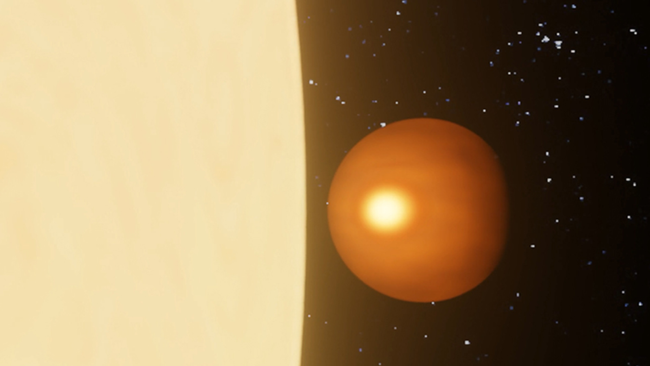Iron Winds and Molten Metal Rain Batter a Scorching Hot Jupiter Exoplanet
“Our observations indicate the presence of powerful iron winds, probably fuelled by a hot spot in the atmosphere.”

“Lower those finger horns. I suppose that ‘Iron Winds and Metal Rain’ would be a good title of a heavy metal album, it is also true that such conditions as on WASP-76b are experienced on the exoplanet. Scientists have found some 4,000 planets outside our solar system and this discovery shows how extraordinary different some of them can be.
WASP-76b is a planet in the Pisces constellation at a distance of around 634 light years away from earth and the temperature which the planet withstands is approximately 4350 degree Fahrenheit (2400 degree Celsius). Which these temperatures get to fry, these are high enough to send iron in a vapor form raining its fury on the planet’s surface.
This is because the planet WASP-76b lies very close to the star which makes it a ‘hot Jupiter’ type of planet. It also causes tidal locking, that is the side that is always facing its star is in perpetual daylight, thus comes with tremendous heat.
Earlier this year, Ph. D. students from the University of Geneva (UNIGE) and the PlanetS National Centre of Competence in Research (NCCR PlanetS) came across supersonic streams that carried evaporated iron from the illuminated part of the planet to the dark side.
During the night side however the temperatures are low and the iron condenses and rains as molten metal droplets.
“This is the first time we have done such precise optical characterization of the day side of the exoplanet thus helping to ascertain some properties of its atmosphere,” stated Ana Rita Costa Silva of the Instituto de Astrofísica e Ciências do Espaço, the first author of the study. ”This give our observations of powerful iron winds in most likely being caused by a hot spot on the planet’s atmosphere. ”
None more metal than WASP-76b
Silva and her team reached their conclusions using light from the dayside of WASP-76b collected by the Echelle SPectrograph for Rocky Exoplanets and Stable Spectroscopic Observations (ESPRESSO) – an instrument located on the Very Large Telescope (VLT).
ESPRESSO is known for its accuracy and stability in addition to this the team was successfully able to acquire a high resolution spectrum of the exoplanet. These spectra revealed dynamics of iron atoms that are present in the atmosphere of the hot Jupiter. This technique is called ‘high resolution emission spectroscopy’ has been found to be a very useful method to analyse the atmospheres of the exoplanets.
‘ESPRESSO requires sub-milliarcsecond accuracy for such stellar mass measurements and is capable of delivering such accuracy,’ added Christophe Lovis, astronomer at UNIGE and part of the NCCR PlanetS team. “Such level of precision enables to study the active processes in exoplanet atmospheres similar to WASP-76b in detail. ”

From the time of its discovery in 2013, WASP-76b has always reproduced as the primary object of study in the field of exoplanet, perpetually dominating media headlines with the kind of conditions that are all but reminiscent of the relatively stable solar system.
For instance, this April scientists were able to identify something called a ‘glory’ in the atmosphere of this stormy globe. To our surprise, glory, which has the appearance of a colorful rain bow-like sets of concentric circles of lights arranged, had not been witnessed before in space unless in a solar system.
This result, combined with the newly identified iron winds, suggests that the atmosphere of exoplanets are not so simple. Identifying such iron winds could help the scientists to build climate models for the WASP-76b and further predict similar phenomena on other hot Jupiter or any other exoplanets.
“The discovery of WASP-76b underlines the types of atmospheric conditions that are sustainable on ultra-hot Jupiters”, said David Ehrenreich, a researcher and a member of the NCCR PlanetS team. Deep investigations of such planets are crucially important for understanding other planets’ climates in general.
The team’s research is published in the journal Astronomy & Astrophysics.
Do not forget to share your opinion with us to provide you with the best posts !



0 Comments